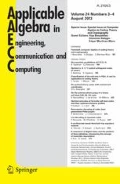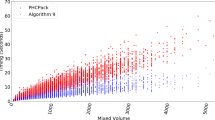Abstract
This paper deals with systems ofm polynomial equations inn unknown, which have only finitely many solutions. A method is presented which decomposes the solution set into finitely many subsets, each of them given by a system of type
. The main tools for the decomposition are from ideal theory and use symbolical manipulations. For the ideal generated by the polynomials which describe the solution set, a lexicographical Gröbner basis is required. A particular element of this basis allows the decomposition of the solution set. By a recursive application of these decomposition techniques the triangular subsystems are finally obtained. The algorithm gives even for non-finite solution sets often also usable decompositions.
Similar content being viewed by others
References
Auzinger, W., Stetter, H. J.: An elimination algorithm for the computation of all zeros of a system of multivariate polynomial equations. ISNM86, Basel: Birkhäuser, 1988
Buchberger, B.: Gröbner bases —an algorithmic method in polynomial ideal theory. In: Progress, direction and open problems in multidimensional systems theory. Bose, N. K. (ed.) pp. 184–232. Amsterdam: D. Reidel
Gianni, P., Trager, B. M., Zacharias, G.: Gröbner bases and primary decomposition of polynomial ideals. J. Symb. Comp.6, 15–33 (1988)
Hietarinta, J.: Solving the Young-Baxter equation in 2 dimensions with massive use of factorizing Gröbner basis computation. Proceedings of ISSAC '92, Acm Press, pp. 55–63
Lazard, D.: Solving zero-dimensional algebraic systems. J. Symb. Comp.13, 117–131 (1992)
Li, T. Y.: Solving polynomial systems. The Math. Intelligencer9, 33–39 (1987)
Marinari, M. G., Möller, H. M., Mora, T.: Gröbner bases of ideals given by dual bases. Proceedings of ISSAC '91, Acm Press, pp. 55–63
Melenk, H., Möller, H. M., Neun, W.:Groebner, A package for Calculating Groebner Bases. Manual, distributed withReduce 3.4,Rand Corporation, 1991
Möller, H. M., Mora, T.: New constructive methods in classical ideal theory. J. Algebra100, 138–178 (1986)
Ortega, J. N., Rheinboldt, W. C.: Iterative solution of nonlinear equations in several variables. New York: Academic Press 1970
Renschuch, B.: Elementare und praktische Idealtheorie, MfL vol.16, Berlin: VEB Deutscher Verlag der Wissenschaften 1976
Schwetlick, H.: Numerische Lösung nichtlinearer Gleichungen. Oldenbourg Verlag 1979
Trinks, W.: Über B. Buchbergers Verfahren, Systeme algebraischer Gleichungen zu lösen. J. Number Th.10, 475–488 (1978)
van der Waerden, B. L.: Moderne Algebra. Vol. I and II, Berlin, Heidelberg, New York: Springer 1966 and 1967
Author information
Authors and Affiliations
Rights and permissions
About this article
Cite this article
Möller, H.M. On decomposing systems of polynomial equations with finitely many solutions. AAECC 4, 217–230 (1993). https://doi.org/10.1007/BF01200146
Received:
Revised:
Issue Date:
DOI: https://doi.org/10.1007/BF01200146




